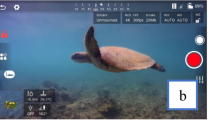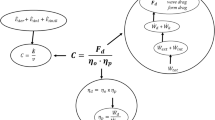Abstract
In nautical literature, ‘dead-water’ refers to the obstructive effect encountered by ships moving in stratified water due to the ship generating waves on an interface that separates different water masses. To investigate the hypothesis that open water swimming may also be obstructed by an encounter of dead-water, possibly causing drowning, we performed two experiments that assess the impact of stratified water on swimming. In the first experiment, subjects made a single front-crawl stroke while lying on a carriage that was rolling just above the water surface. The gain in kinetic energy, as a result of the stroke, was far less in stratified than in homogeneous water. In the second experiment, four subjects swam a short distance (5 m) in homogeneous and in two different settings of stratified water. At the same stroke frequency, swimming in stratified conditions was slower by 15%, implying a loss in propulsive power by 40%. Although in nature stratification will be less strong, extrapolation of the results suggests that dead-water might indeed obstruct swimming in open water as well. This effect will be most pronounced during fair weather, when stratification of a shallow surface layer is most easily established. Our findings indicate that swimmers’ anecdotal evidence on ‘water behaving strangely’ may have to be taken more seriously than previously thought.




Similar content being viewed by others
References
Costill DL, Maglischo EW, Richardson AB (1992) Swimming. Blackwell, London
Ekman VW (1904) On dead-water. Sci Results Norw North Polar Exped 1893–1896:5
Esler JG, Rump OJ, Johnson ER (2007) Non-dispersive and weakly dispersive single-layer flow over an axisymmetric obstacle: the equivalent aerofoil formulation. J Fluid Mech 574:209–237
Farmer DM, Smith JD (1980) Tidal interaction of stratified flow with a sill in Knight Inlet. Deep Sea Res 27A:239–254
Fish FE (1996) Transitions from drag-based to lift-based propulsion in mammalian swimming. Am Zool 36:628–641
Maas LRM, van Haren JJM (2006) Worden mooi-weer verdrinkingen door dood-water veroorzaakt. Meteorologica 15:211–216, (in Dutch)
Miloh T, Tulin MP, Zilman G (1993) Dead-water effects of a ship moving in stratified seas. J Offshore Mech Arctic Eng 115:105–110
Nansen F (1897) Farthest north. The Norwegian Polar Expedition 1893–1896. Archibald Constable, Westminster, pp 1–2
Padisák J, Reynolds CS (2003) Shallow lakes: the absolute, the relative, the functional and the pragmatic. Hydrobiologia 506–509:1–11
Peden MM, McGee K (2003) The epidemiology of drowning worldwide. Inj Control Saf Promot 10:195–199
Pite HD, Topham DR, van Hardenberg BJ (1995) Laboratory measurements of the drag force on a family of two-dimensional ice keel models in a two-layer flow. J Phys Oceanography 25:3008–3031
Sokal RR, Rohlf FJ (1995) Biometry: the principles and practice of statistics in biological research, 3rd edn. Freeman, New York, 887 pp
Takagi H, Wilson B (1999) Calculating hydrodynamic force by using pressure differences in swimming. In: Keskinen KL, Komi PV, Hollander AP (eds) Biomechanics and medicine in swimming VIII. University of Jyväskylä, Jyväskylä, pp 101–106
Toussaint HM, Truijens M (2005) Biomechanical aspects of peak performance in human swimming. Animal Biol 55:17–40
Toussaint HM, Beelen A, Rodenburg A, Sargeant AJ, de Groot G, Hollander AP, van Ingen Schenau GJ (1988) Propelling efficiency of front crawl swimming. J Appl. Physiol 65:2506–2512
Toussaint HM, Hollander AP, de Groot G, Kahman R, van Ingen Schenau GJ (1990) Power of leg kicking in front-crawl swimming. In: Berme N, Capozzo A (eds) Biomechanics of human movement. Bertec, Worthington, pp 456–459
Toussaint HM, Janssen T, Kluft M (1991) Effect of propelling surface size on the mechanics and energetics of front crawl swimming. J Biomech 24:205–211
Tulin MP, Yao Y, Wang P (2000) The generation and propagation of ship internal waves in a generally stratified ocean at high densimetric Froude numbers, including nonlinear effects. J Ship Res 44:197–227
Vennell R, Pease D, Wilson B (2006) Wave drag on human swimmers. J Biomech 39:664–671
Walker JM (1991) Farthest North, dead-water and the Ekman spiral, Part 2. Weather 46:158–164
WHO (2002) The World Health Report, 2002: Reducing Risks, Promoting Healthy Life. World Health Organization, Geneva
Acknowledgements
We thank B. den Brinker, H. de Koning, and S. Groot for technical support and A. Gieles, P. Gieles, and F. Ganzevles-Gieles for their assistance. We are grateful to the referees for constructive remarks. The experiments comply with the current laws of The Netherlands.
Author information
Authors and Affiliations
Corresponding author
Rights and permissions
About this article
Cite this article
Ganzevles, S.P.M., van Nuland, F.S.W., Maas, L.R.M. et al. Swimming obstructed by dead-water. Naturwissenschaften 96, 449–456 (2009). https://doi.org/10.1007/s00114-008-0493-6
Received:
Revised:
Accepted:
Published:
Issue Date:
DOI: https://doi.org/10.1007/s00114-008-0493-6




